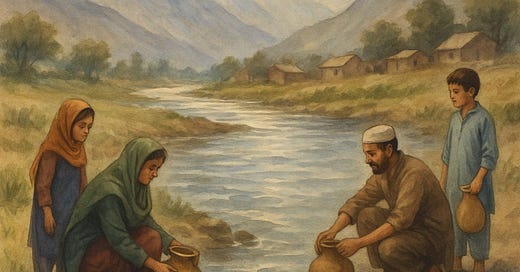Rivers of Hope: Let The Water Break The Ice
Despite political divides, communities along the Indus River system unite through shared water, climate challenges, and grassroots cooperation—proving that rivers can be bridges, not boundaries.
Before dawn breaks over the snow-capped Pir Panjal range, two families—separated by a thin line on the map—gather at the riverbank. Each lifts a clay pot from the swirling waters of the Jhelum. Though their governments may sit at distant negotiation tables, here on the riverbank, they share the same silent prayer: that this lifeline never runs dry and never becomes a sword.
Flowing Through History:
For centuries, the Indus River system and its tributaries have nurtured the valleys of Kashmir, winding through villages on both the Pakistani and Indian sides of the Line of Control. In 1960, at the height of geopolitical tension, Pakistan and India surprised the world by signing the Indus Waters Treaty, brokered by the World Bank.
Despite wars and political upheavals, the treaty has endured for over sixty years, allocating the western rivers (Indus, Jhelum, Chenab) to Pakistan and the eastern rivers (Ravi, Beas, Sutlej) to India under a strict dispute-resolution mechanism.
A Shared Climate Challenge:
Today, melting glaciers and shifting monsoon patterns impose new stresses on the same waterways that once guaranteed seasonal predictability.
Temperatures in the Himalayas have risen steadily, causing glaciers to shrink and threatening downstream flows during the dry season.
Farmers on both sides grapple with unpredictable floods in spring and parched fields by summer’s end; urban centres struggle to deliver reliable drinking water.
In this era of climate change, no single community can insulate itself from others’ water shortages—cooperation isn’t just altruism; it’s a practical lifeline.
Track-Two Bridges - People Reaching Across Borders:
While governments debate treaties and power-sharing, civil-society initiatives have quietly built trust along riverbanks:
Flood-Alert Apps: The IoT-based “Kashmir Flood Alert” mobile app streams real-time water-level data from Jhelum gauge stations, providing communities on both sides with early warnings of rising flows.
Citizen-Science Monitoring: Student groups use open-source apps—like the Water SCIENCE Monitor—to test and map water quality, sharing results online to highlight pollution hotspots.
These grassroots efforts foster a sense of shared purpose and data-driven dialogue, demonstrating that river health transcends political boundaries.
Mutual Gains from Water Cooperation:
Practical examples of cross-border water projects point to broader benefits:
Hydropower Partnerships: Under SAARC’s proposed joint water management framework, small run-of-river projects co-financed by Indian and Pakistani entrepreneurs could lower energy costs for remote villages while sharing profits equitably.
Flood-Early-Warning Networks: Monitoring glacial outflows and lake levels can warn downstream communities of glacial-lake-outburst floods (GLOFs), which experts estimate threaten millions in the region.
Riverbank Restoration: Cooperative tree-planting brigades help stabilize eroding banks, curb sedimentation, and improve fish habitats—outcomes that benefit ecosystems irrespective of which side of the Line of Control they occur on.
By pooling technical expertise and financial resources, these initiatives deliver environmental stability and economic dividends, proving that water cooperation pays across sectors.
Flowing Toward a “Water for Peace” Forum:
Building on these successes, formal institutions can solidify water-based dialogue:
Expand the Indus Waters Commission to include youth and civil-society representatives who review hydrological data and pilot joint projects biennially.
Establish a “Water for Peace” Council under a neutral SAARC-style or NGO umbrella, tasked with mediating local cooperation and publicizing success stories.
Fund Joint Research Hubs at universities on both sides, focusing on glacial monitoring, sustainable irrigation, and community-driven governance to inform adaptive strategies.
By transforming shared water challenges into platforms for collaboration, these measures can shift perceptions, underscoring that rivers bind people together, not pull them apart.
If the river can flow uninhibited, so too can dialogue, trust, and ultimately peace. Let each drop remind us: our futures are entwined downstream.








«Our futures are entwined downstream» That’s the world I will sign up for! Thank you for writing :-)
Perfectly aimed, perfectly timed. 💚